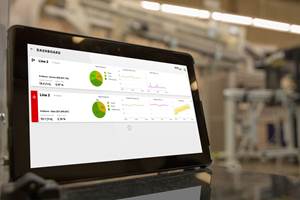Portable CMM Helps Thermoformer Hold Tight Tolerances in Large Parts
Thermoform Plastics Inc. (TPI) in St Paul, Minn., believes it has found a better way to guarantee dimensional accuracy in large parts with complex shapes.
Thermoform Plastics Inc. (TPI) in St Paul, Minn., believes it has found a better way to guarantee dimensional accuracy in large parts with complex shapes. The company specializes in rotary forming of large, multi-dimensional parts for automotive, specialty-vehicle, marine, and other markets. A sound method for ensuring dimensional accuracy is imperative in most of the programs TPI pursues. However, most traditional methods of verifying part dimensions are bulky, expensive, time-consuming, and often unreliable. Instead, TPI has adopted a portable coordinate-measuring machine called the Control Station Pro (CSP), supplied by Faro Industries Inc. in Lake Mary, Fla. TPI uses five CSPs to validate tools and parts, check CAD drawings, and reverse engineer prototypes.
By using CSP, TPI has been able to win new customers and design more complex parts than before, according to John Zeidlick-Zimney, TPI corporate quality-assurance manager. He cites examples like a burial vault with multi-radii surfaces, the skin of a fire truck comprising more than a dozen parts, and a recreational boat deck that incorporates intricate mounts and cutouts.
Big parts are difficult
In the past, TPI verified dimensional accuracy in parts like these with mechanical rigs of gauges, calipers, rules, clamps, tapes, etc. It was a low-cost way to measure sample parts for fit and finish (e.g., hole or cutout position). However, it consumed a great deal of time, notes Zeidlick-Zimney, since the rigs required constant repetitive manual operations and resetting of parameters. He adds that this approach is subject to error drift and inaccuracy.
Another option would be traditional coordinate measuring machines, or CMMs, but they are typically mounted on a fixed-bed and occupy considerable space. They are also costly.
In response, TPI shifted to Faro’s CSP system as a more affordable and versatile method for measuring dimensional accuracy in formed parts. The Faro system can be used in the laboratory or deployed on the production floor by using a portable tripod. For about one-tenth the cost of a traditional CMM, Faro’s $39,900 package includes portable hardware and recently upgraded computer software.
CSP is based on a six-axis, articulated arm with a probe on the end that can be manually manipulated to lightly touch points on a part surface. At each touch, the computer records 3D coordinates to ±10 mils. (TPI’s part tolerances are ±30 to 60 mils.) The arm’s reach covers the full gamut of parts made by TPI: 10 x 22 ft x 58-in. draw. An optional port allows the attachment of scanners, sensors and other electronic probes to the arm.
First-article checking
The system has proved important in validating dimensions of initial parts from a new tool. TPI now outsources most of its tool building, which makes capability studies on initial parts more critical than ever. Zeidlick-Zimney estimates that capability studies that once took five shifts can now be done in one shift or less.
Another CSP capability is cross checking the dimensions of tools and parts against original CAD drawings. As the probe touches points on the part or tool, the CAM2 software draws an image on a PC screen in real time, so the inspection team can immediately compare measured features with those on the original CAD drawing.
A third benefit is the ability to enter data into existing SPC software. CSP can be programmed to create a library of measured data based on periodic checks of part or tool dimensions. That helps TPI generate validation data for easy transfer to customers who require it.
Finally, CSP gives TPI a low-cost method for “reverse engineering.” The system can be used to record 3D coordinates of a clay model and translate them directly into a CAD file.
Related Content
How Inline Vision Inspection Can Minimize Scrap in Molding
Once viewed by injection and blow molders as a necessary evil, machine vision technology today can continuously monitor and improve production while reducing costs.
Read MoreTracing the History of Polymeric Materials -- Part 30: Polyurethane
In the world of polymers, polyurethane chemistry is probably the most versatile. This a resulted in a wide range of products made from these materials and given the industry the flexibility to respond to the progressive march of regulatory concerns.
Read MoreFast, Simple QC Method Directly Quantifies Recycled Content in Plastics
Novel fluorescence-based spin-out technology provides a rapid and reliable method to measure and certify recycled content in a wide range of plastics.
Read MoreHow to Improve Quality with Offline Inspection and Analysis
Automated sample testing with a light table detects the smallest contamination in flakes, micro granulates and sample test sheets.
Read MoreRead Next
How Polymer Melts in Single-Screw Extruders
Understanding how polymer melts in a single-screw extruder could help you optimize your screw design to eliminate defect-causing solid polymer fragments.
Read MoreAdvanced Recycling: Beyond Pyrolysis
Consumer-product brand owners increasingly see advanced chemical recycling as a necessary complement to mechanical recycling if they are to meet ambitious goals for a circular economy in the next decade. Dozens of technology providers are developing new technologies to overcome the limitations of existing pyrolysis methods and to commercialize various alternative approaches to chemical recycling of plastics.
Read More























